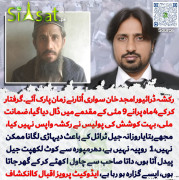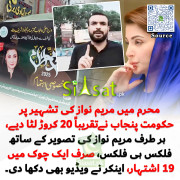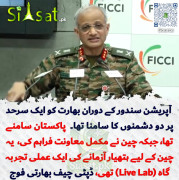
NEW DELHI — The Media One anchorman Vinesh Kunhiraman went on air as usual on March 6, ready to tell the station’s five million viewers in India’s Kerala State about the death anniversary of a beloved comedian and the latest news on the coronavirus pandemic.
Just a few minutes into the broadcast, he saw the managing editor rush to the studio floor, gesturing wildly. “I realized something was not right,” Mr. Kunhiraman recalled.
The station’s uplink suddenly went dead. Mr. Kunhiraman’s image dissolved into a blue screen. A bland message told viewers there was no signal. “We regret the inconvenience,” it said.
But this was no technical difficulty. The station had been cut off by an order from India’s Ministry of Information and Broadcasting. The government decided to block the channel for 48 hours because it had covered February’s biggest news story — the mob attacks on Muslims in New Delhi that flared into broader unrest — in a way that seemed “critical toward Delhi Police and R.S.S.,” the order said.
The R.S.S. is a Hindu-nationalist social movement with close ties to Prime Minister Narendra Modi and his Bharatiya Janata Party.
“It was shocking the central government took such a decision,” said R. Subhash, an editor at Media One. “It was an attack on the freedom of the press.”
India’s free press has played a crucial role in protecting this country’s democracy since its independence from Britain in 1947. But journalists here now feel under attack.
Since Mr. Modi came to power in 2014, they say, his government has tried to control the country’s news media, especially the airwaves, like no other prime minister in decades. Mr. Modi has shrewdly cultivated the media to build a cult of personality that portrays him as the nation’s selfless savior.
At the same time, senior government officials have pressed news outlets — berating editors, cutting off advertising, ordering tax investigations — to ignore the uglier side of his party’s campaign to transform India from a tolerant, religiously diverse country into an assertively Hindu one.
With the coronavirus pandemic, Mr. Modi has gotten more blatant in his attempt to control coverage and, as with other difficult stories, some Indian news executives seem willing to go along.
ImageNews media covering antigovernment protests in New Delhi in February.
News media covering antigovernment protests in New Delhi in February.
Right before he announced the world’s largest coronavirus lockdown, on 1.3 billion people, Mr. Modi met with top news executives and urged them to publish “inspiring and positive stories” about the government’s efforts. Then, after the lockdown stranded half a million migrant workers, with some dying along the highways, his lawyers persuaded the Supreme Court this week to order all media to “publish the official version” of coronavirus developments, although outlets are still allowed to carry independent reporting.
An association of leading broadcasters was quick to praise the court decision, which many intellectuals said was yet another attack on India’s constitutionally guaranteed freedom of speech.
Through an aide, India’s information and broadcasting minister, Prakash Javadekar, initially agreed to discuss the government’s media policies. But in the two weeks since then, Mr. Javadekar has declined to answer any questions, including a written list emailed to him. His aide cited the demands of the coronavirus crisis.
India’s media universe is vast, perhaps the biggest in the world: More than 17,000 newspapers, 100,000 magazines, 178 television news channels and countless websites in dozens of languages. Thousands of Facebook pages call themselves news publishers, and YouTube is filled with local bulletins on everything from real estate trends to police raids.
But Mr. Modi’s ministers have leaned on business leaders to cut off support to independent media, slowly strangling their operations. His government has pressured media owners to fire journalists who have criticized the prime minister and told them to stop running features like hate-crime trackers that have embarrassed Mr. Modi’s party.
Mr. Modi is backed up by an army of online allies who discredit and harass independent journalists; female journalists, in particular, have been besieged with abuse and rape threats. And the police say Hindu nationalists were behind the 2017 murder of Gauri Lankesh, a female newspaper editor hailed as one of India’s most crusading journalists.
Like other populist leaders, Mr. Modi and his ministers bristle at any public criticism, whether from business executives, foreign leaders, or even schoolchildren.
And for the most part, Indian news outlets have knuckled under, concluding that since much of the public supports the prime minister, they should, too. Even skeptical journalists censor themselves, afraid to be branded anti-national by a government that equates patriotism with support for Mr. Modi.
His government has also imposed the strictest restrictions on foreign journalists in decades, suddenly and without explanation. Visas have been tightened, and foreign journalists have been banned from hotbeds of unrest such as northeast India and Jammu and Kashmir, a Muslim-majority area that was stripped of its statehood in August and put under a severe crackdown.
The Kashmir story was seismic, but many Indian journalists, looking back on it, feel that they toed the government line and overlooked grave human rights abuses.
“We didn’t do justice to the big story,’’ said Rajdeep Sardesai, one of the country’s leading news anchors. “We should have gone out there and reported the situation from the ground aggressively and independently.’’
There were security restrictions on where Indian reporters could go, Mr. Sardesai said, but he admitted it was more than that.
“A large section of the Indian media,” he said, “has become a lap dog, not a watchdog.”
The business model in India doesn’t help. Well before Mr. Modi first became prime minister in 2014, newspapers and television stations have relied on government advertising, allowing politicians to reward friendly outlets and punish critics.
And media owners often run other businesses for which they need the government’s favor, making them reluctant to take on those in power.
With the coronavirus pandemic dampening advertising and restricting newspaper circulation, news organizations are now sliding into crisis. One of the most independent, The Indian Express, just decided to cut salaries.
Even as Mr. Modi constantly touts India as the world’s largest democracy, its ranking on the Reporters Without Borders press freedom index is 140 out of 180.
“In the past six years, the Indian media has deteriorated,” said Shakuntala Banaji, a media professor at the London School of Economics. “There is no semblance of truth or responsibility left in the vast majority of media reports.”
Pressuring the advertisers
The apologetic calls from advertisers have become so common that NDTV executives are no longer surprised.
One corporate boss begged the station to take his company’s logo off the screen, saying the government was squeezing him too hard. Another executive broke down in tears as he canceled a large advertising contract.
No TV channel has come under more pressure from Mr. Modi’s government than NDTV, an influential network that airs in English and Hindi. Mr. Modi’s grudge goes back to 2002, when he was chief minister of Gujarat State, and NDTV journalists reported that his government stood by while hundreds of Muslims were massacred in religiously driven violence.
When Mr. Modi became prime minister, his administration began a full-scale assault on NDTV. The government accused it of laundering money through a deal with NBC, the American TV network. The accusations have dragged on for years, and NDTV denies any wrongdoing.
“The thing in India is, you can file a case, and win it 10 years later,” said Prannoy Roy, one of NDTV’s founders. “The process is the punishment.”
The effort to brand NDTV as unpatriotic has been devastatingly effective. In one November 2016 email, the luxury automaker Daimler told NDTV that it would not proceed with a marketing campaign because “there are people associated with the channel that are linked to anti-India stuff, by the public at large.”
A Daimler spokeswoman said Friday that the email did not reflect the company’s views and that the campaign had been rejected for economic reasons.
As money dried up, the station laid off hundreds of journalists. NDTV now gets much of its advertising from state governments, many of which are controlled by opposition parties.
‘Stay firmly with the national government’
Many within India’s news firmament have embraced Mr. Modi, sensing how much the popular mood has swung away from India’s founding secularism and toward Mr. Modi’s brand of strident Hindu nationalism. Right-wing TV anchors, led by Arnab Goswami of Republic TV, compete to outdo one another as the loudest Modi supporters.
As the government announced the crackdown in Kashmir, M.K. Anand, the managing director of Times Network, sent his editors a directive.
“We are India’s leading news broadcasters,” he wrote in a WhatsApp message, seen by The New York Times. “It is important that we stay firmly with the national government at this juncture instead of focusing on finding faults.”
The Modi government has been particularly concerned about broadcast media, which reach into every corner of the country. It has approved very few new TV channels, and even Bloomberg, the American media giant, has been unable to get a license, despite investing millions of dollars with its Indian partner.
In this environment, sharp criticism of Mr. Modi can end careers. After a host at the Hindi news channel ABP questioned the results of one of the prime minister’s initiatives to help poor farmers, the satellite transmission of the show was interrupted every time it was broadcast, said several people who worked at the station. The channel’s owners pressured the host, Punya Prasun Bajpai, to resign, and as soon as he left, the transmission interruptions stopped, the former employees said.
And after another ABP anchor, Abhisar Sharma, criticized Mr. Modi on live television about public safety, he was pulled off the air the same day. He, too, said he was pressured to quit.
Mr. Sharma then took to YouTube to broadcast his commentary, but pro-Modi trolls followed him into cyberspace. Every time he uploaded a video — and some drew millions of views — YouTube would receive thousands of complaints that he had made inappropriate remarks, Mr. Sharma said. The site’s algorithm then blocked any advertising revenue he would have made.
“You can’t escape them,” he said.
Attacking the messenger
Small-town journalists have come under government attack, as well.
Last August, Pawan Kumar Jaiswal, a part-time journalist who also ran a tiny mobile phone accessories shop, broke a story revealing how poor children in a school near Varanasi, Mr. Modi’s parliamentary constituency, were being fed only flatbread and salt for lunch — a clear violation of government nutrition rules.
After his short video went viral, a state education officer filed a criminal complaint against Mr. Jaiswal, accusing him of conspiracy, false evidence and cheating, a crime that can draw up to seven years in jail.
His source at the school was promptly arrested. Fearing he was next, Mr. Jaiswal fled to New Delhi, where he hid for several weeks.
“Sometimes I felt like committing suicide,’’ he said.
Even though an investigation eventually vindicated his reporting and the police dropped the charges against him, Mr. Jaiswal continues to be stalked by people connected to the school, he said.
He has reason to be afraid. Several Indian journalists have been killed in recent years, from a Kashmiri newspaper editor shot outside his office to a young journalist in Chhattisgarh found tied up in a forest.
“This is the life of a local reporter,” Mr. Jaiswal said.
‘Responsible Freedom’
The shutdown of Media One and another Kerala television station, Asianet News, in March was a new twist. Both stations broadcast in Malayalam, a local language spoken by less than 3 percent of Indians. And both channels had aired witness accounts that echoed what many other outlets aired during the violence in Delhi: that the police had done little to stop Hindu mobs as they rampaged against Muslims.
But the broadcast ministry claimed that what these two stations reported “could enhance the communal disharmony across the country.” After many complaints about the shutdown, the broadcasting minister, Mr. Javadekar, reversed the orders the next morning.
“Press freedom is absolutely essential in a democratic setup and that is the commitment of the Modi government,” Mr. Javadekar said at a news conference, implying that the orders had been issued without his consent.
“But let me also say,” he concluded, “that everybody accepts that it has to be a responsible freedom.”

Under Modi, India’s Press Is Not So Free Anymore (Published 2020)
India’s government has pressured advertisers and even shut down channels to shape the information that 1.3 billion Indians receive. It’s part of a wider assault on dissent.
Last edited by a moderator:




































